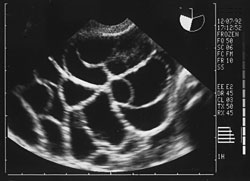 |
| A normal ovary at rest |
 |
| An ovary after hyeprstimulation, prior to egg retrieval |
This recent article in the NY Times captures the essence of the debate that is going on in the infertility community regarding the use minimal stimulation in in vitro fertilization. Hit the jump for my thoughts on this article!
The first child born in the world (it was in the UK) from In vitro fertilization, Louise Brown, was the result of a unstimulated cycle...her surgeons retrieved one egg using a laparoscope. This process seemed a bit inefficient and the pioneers of IVF in the US, Howard and Georgeanna Jones used exogenous hormones (human menopausal gonadotropins (hMG) to increase the egg yield to enhance the likelihood of achieving a successful live birth from IVF. You could say that the Jones's approach served as a blueprint of sorts that helped bring infertility treatments into their current state
Right now, "minimal stimulation" IVF protocols, as they have been dubbed by some, in a way, are a throwback to the past. However, many still view minimal stimulation as a "fringe" treatment, mainly because, as pointed out by some of the physicians quoted in the article (Schattman and Gibbons are highly regarded experts in our field), the pregnancy rates are lower. But they are gaining more momentum as investigation into their effects increases.
The article's title "HIGH DOSES OF HORMONES FAULTED IN FERTILITY CARE" inherently posits that women are getting TOO much drug ALL THE TIME, wihtout regard to individual patient history and risk factors and THIS IS STANDARD OPERATING PROCEDURES. This title is misleading!
Most clinics take into account a patient's age, weight, infertility diagnosis, ultrasound findings, certain routine blood tests, previous treatment history to determine what is the best medication dose and "protocol" for the patient. We then adjust the dose based on the patient's labwork and if there is a concern for severe OHSS we wait and perform a frozen embryo transfer the following cycle. Furthermore, in certain patients with risk of developing severe OHSS, we also consider giving a medicine to help reduce the physiologic mechanism that amplifies OHSS.
Severe OHSS is a very serious, rare, side effect of ovarian hyper stimulation performed during IVF. Along with the severe fluid collection, potential need for a fluid removal procedure and hospitalization, patients are at risk for ovarian torsion (where the ovary twists on itself - a surgical emergency), and blood clots that could potentially be life threatening if formed in the lung. Our field does not take any OHSS lightly when counseling patients, and it has been looking for ways to relieve the burden of OHSS and minimal stimulation protocols, especially as laboratory (in vitro) techniques have improved, might be one approach.
But, not all patients are equal either and while some argue for a place for minimal stimulation protocols or "mini IVF," there needs to be more evidence to support minimal stimulation, before it becomes a standard option.
Finally got around to catching up on your blog. I love it! I really enjoy reading your perspective on infertility related news stories and think that your blog is a great resource for patients looking for well-rounding information. Keep it up!
ReplyDelete